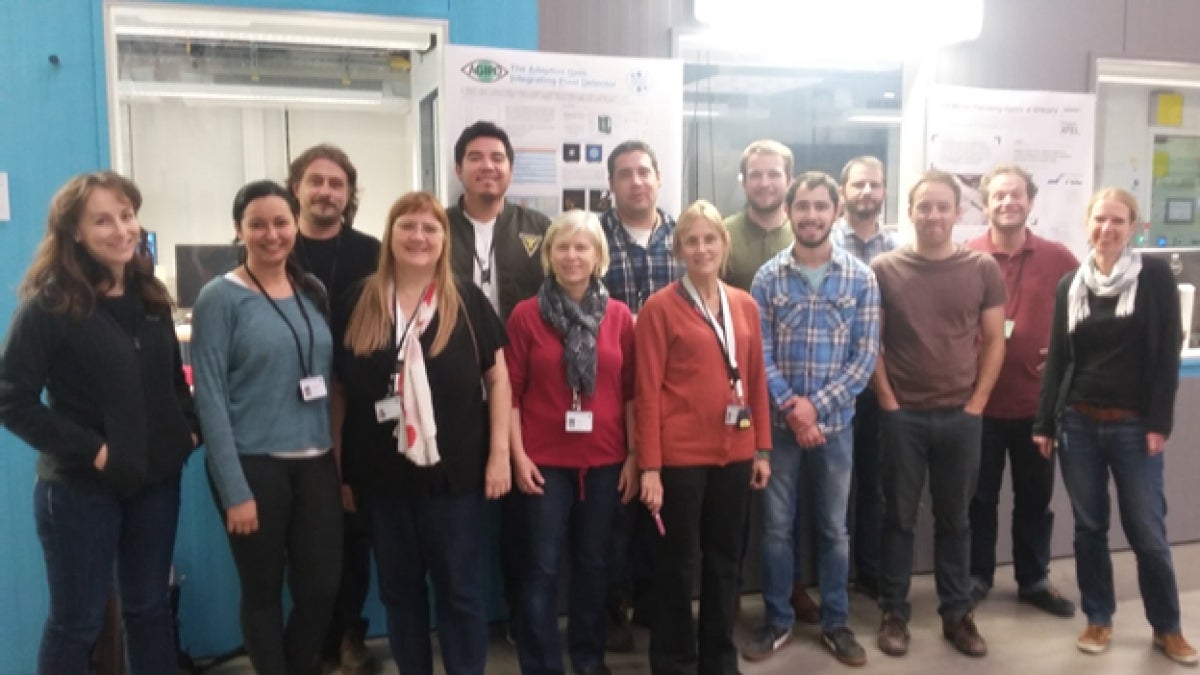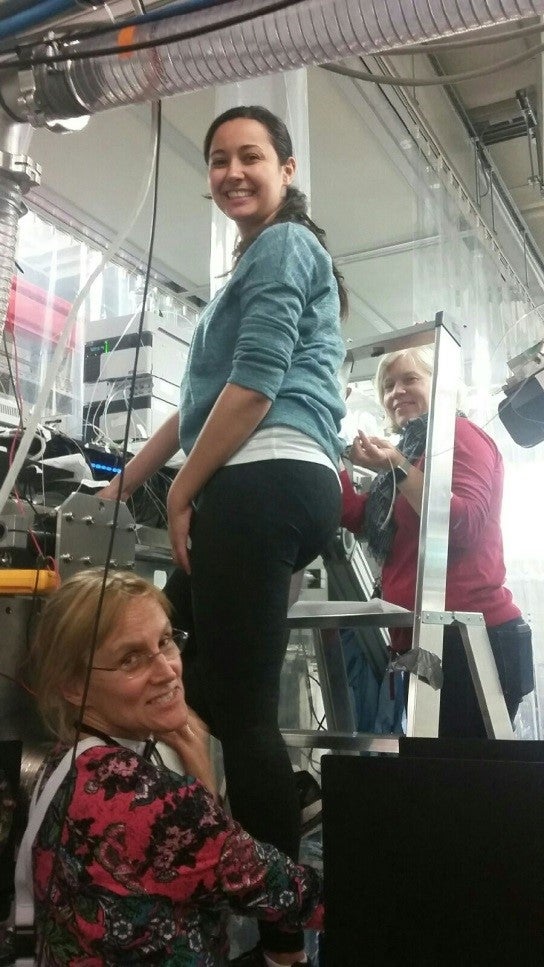ASU team among first user groups at Europe’s brightest light source

The ASU team with EuXFEL beam line scientists during one of the designated shifts. The experimental hutch is behind the team. From left: Nadia Zatsepin (ASU), Jorvani Cruz Villarreal (ASU), Patrik Vagovič (EuXFEL), Petra Fromme (ASU), Jose Meza Aguilar (ASU), Alexandra Ros (ASU), Jesse Coe (ASU), Ana Egatz Gomez (ASU), Gerrit Brehm (ASU / Georg August Univeristy Goettingen), Austin Eichelmeyer (ASU), Richard Kirian (ASU), Richard Bean (EuXFEL), Marc Messerschmidt (EuXFEL), Katherina Doerner (EuXFEL).
A team of ASU scientists led by Professor Alexandra Ros in the School of Molecular Sciences and the Biodesign Center for Applied Structural Discovery, has been just the second user group to conduct experiments at the brand new European X-ray free electron laser facility (EuXFEL) in Hamburg, Germany. This 1.5-billion-dollar facility is the third, and far the most powerful, X-ray laser in the world. After ten years of construction, it opened for first experiments just a month ago.
The XFEL best known to U.S. scientists has been the Stanford Linear Accelerator Center (SLAC) facility where the now-famous work on crystallography of protein nanocrystals (by the ASU team led by Professors John Spence and Petra Fromme) was carried out. SLAC and its companion in Europe, also at Hamburg, have been very successful and in consequence, have become heavily overbooked. The coming-on- line of the new facility, with its giant 2.6-mile accelerator tunnel and atomic length scale resolution, will relieve some of the demand on the other facilities, while offering grand new possibilities in the physical sciences as well.
ASU is the only U.S. institution leading one of these first pioneering experiments at the EuXFEL, which took place from September 21 to 25, 2017. Professor Ros’ team and collaborators worked at the recently opened facility to perform crystallography experiments at the SPB/SFX (Single Particles, Clusters, and Biomolecules and Serial Femtosecond Crystallography) experimental setup.
The SPB/SFX instrument will be used to gain a better understanding of the shape and function of biomolecules, such as proteins, that are otherwise difficult to study. Several of the seven first experiments on this instrument will focus on method development for these new research opportunities at the European XFEL or ways to reduce the amount of precious sample used for the examination of biological processes. Other groups will be studying biological structures and processes such as the water splitting process in photosynthesis.
The goal of Ros’ team is to solve one of the main challenges of the EuXFEL based on its unique pulse train structure: The X-ray shots (destroying any solid material) come in 10 pulse trains per second with several thousand X-ray shots in one of the trains. Within each train these shots are only 1 millionth of a second apart. The means of delivering tiny crystals super-fast to the X-ray beam, so that each of the X-ray shots hits a fresh crystal without the requirement of using huge amounts of the precious crystals is a major challenge.

(From left) Ana Egatz Gomez, research scientist, Jorvani Cruz, graduate student, and Alexandra Ros, associate professor and principal investigator, aligning and assembling the droplet injection setup on top of the vacuum chamber in the SPB/SFX hutch at the EuXFEL.
Professor Ros has developed a novel microfluidic system that was tested and implemented for the first time at the beamline allowing researchers to deliver droplets of biomolecule crystals within an oil phase and thereby inject the crystals in the aqueous phase only when the fast X-ray laser fires its pulse trains. The protein chosen for this study was the enzyme 3-deoxy-D-manno-octulosonate 8-phosphate synthase (KDO8PS), which is a potential antibiotic target.
Being one of the first three user-teams at the newly opened EuXFEL came with plenty of challenges, but the ASU team was up to the task! They successfully generated the tiny aqueous protein crystal droplets in an oil phase, injected them creating a fast jet and saw the first images from the diffraction of the enzyme crystals. The data obtained are currently being evaluated and preparations for publishing the results are under way.
The ASU team members who participated during the beam time on site in Hamburg included Austin Echelmeier, Jorvani Cruz-Villarreal, Ana Egatz-Gomez, Gerrit Brehm, Jesse Coe, Jose Meza Aguilar, Nadia Zatsepin, Petra Fromme, Richard Kirian, and Alexandra Ros. Stella Lisova, Sebastian Quintana, Uwe Weierstall and John Spence participated remotely. The experiment was supported by the Sample Environment group at the EuXFEL, the beam line scientists at the EuXFEL, and Professor Henry Chapman’s team at DESY, Germany. The project is financially supported by the NSF BioXFEL Science and Technology Center, the Biodesign Center for Applied Structural Discovery as well as a grant from NIH.
More Science and technology

ASU professor breeds new tomato variety, the 'Desert Dew'
In an era defined by climate volatility and resource scarcity, researchers are developing crops that can survive — and thrive —…

Science meets play: ASU researcher makes developmental science hands-on for families
On a Friday morning at the Edna Vihel Arts Center in Tempe, toddlers dip paint brushes into bright colors, decorating paper…

ASU water polo player defends the goal — and our data
Marie Rudasics is the last line of defense.Six players advance across the pool with a single objective in mind: making sure that…

